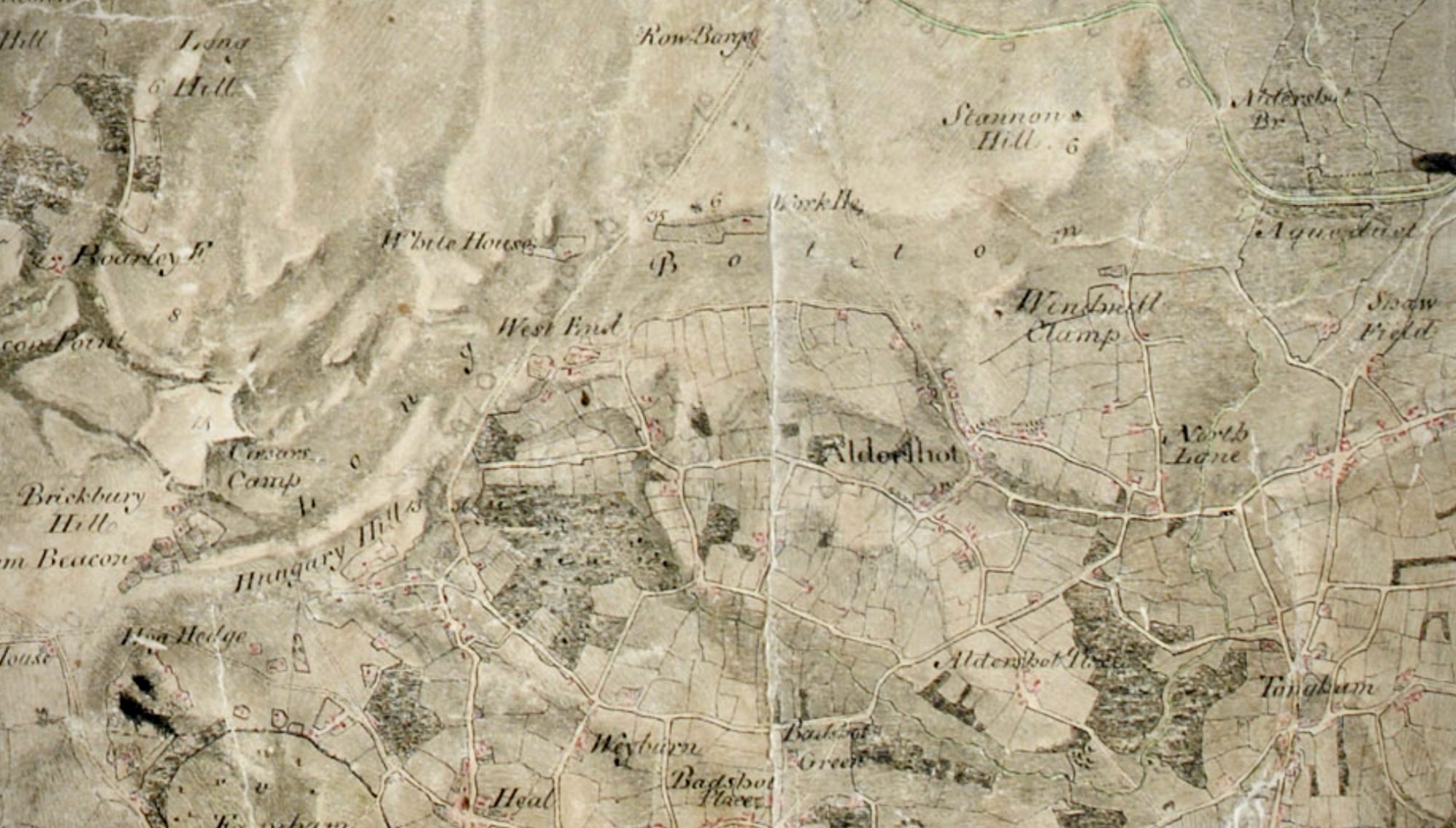John Eggar of Aldershot and Bentley
* Note: This account overturns much of the written history about the arrival of John Eggar into Aldershot; it also begins to challenge generalisations ascribed to the Aldershot Manor Halimote.
The Eggar family were long established at Bentley, their tombstones occupying the largest part of the churchyard of St Mary’s Church. Those of the Baigent and Benham families also featured. The Eggars also held properties at Holybourne where other members of the extended family were buried, their significance for the wider area signalled by Alton Grammar School which John Eggar of Crondall had founded in 1641.
The Eggar Brothers
Two of the several children born to Thomas and Jane Eggar were to play key roles in Aldershot’s history. Both John and his younger brother Samuel were baptized in the neighbouring parish of Holybourne, John in December 1773 and Samuel in October 1779. The sons of their younger brother George, would also later play a part.

The eldest son James took on their father’s farm in Bentley. John Eggar began farming on the other side of Farnham, in Runfold, close by Aldershot. He would owe his significance to Aldershot’s history to Thomas Buddle, his uncle by marriage to Mary, his father’s sister.

Inheritance
It has become commonplace to state that John Eggar inherited the Aldershot Halimote Manor estate, including the Manor House, from Mr Buckle, supposedly an uncle who had bought the whole property at auction in 1831. This is incorrect.
James Alfred Eggar, the grandson of John’s younger brother George, made that statement on page 54 of his book, ‘Remembrances of Life and Customs’ (1924). However, later in that same book, Eggar contradicts this directly on page 201, in a section entitled ‘Corrections and Additions’:
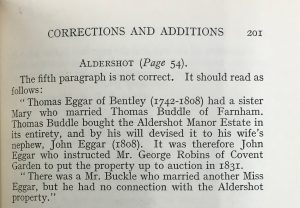 ‘Remembrances of Life and Customs’ (J.Alfred Eggar, 1924), National Library of Scotland.
‘Remembrances of Life and Customs’ (J.Alfred Eggar, 1924), National Library of Scotland.
Thomas Buddle, born in 1739, was a maker of mathematical instruments at the time of his marriage in Farnham to Mary Eggar in June 1765; she was noted as then living in Bermondsey. Buddle was recorded as a mercer taking on an apprentice in Farnham in 1766.
Buddle began making purchases of property in Aldershot in 1783, including a house with a garden and orchard, and in 1785, he bought a farmstead later, respectively, known locally as Riley’s and Legg’s, neither having any direct connection with possession of the Aldershot Halimote Manor.
In June 1790, a “desirable estate, situate(d) in an eligible and sporting part of the country” came up for sale at the Bush in Farnham, “comprising the Manor of Aldershot, with Court Baron etc …” and “also a small farm adjoining of between sixty and seventy acres”.
 Times, 29 May 1790
Times, 29 May 1790
The Court Baron belonged to this property, although the term ‘Manor of Aldershot’ used in the advertisement in 1790, over-states the status and is misleading.
Thomas Buddle had possession by 1793, his ownership confirmed in the Land Tax Return for 1800. By then, Buddle owned a considerable extent of property in Aldershot, the total Rental Value of £93 being the largest for any landowner, even greater than the £74 for the freehold property at Aldershot Park.

The mansion and its estate, to which the Court Baron belonged, was valued at £45. Riley’s Farm, the collective name for the collective of lands bought by Buddle in the 1780s, at £36 and Legg’s at £7.
By 1803, John Eggar was working the majority of his uncle’s holdings in Aldershot, seemingly occupying what was later referred to as the ‘Great House’ and having taken over the management of Riley’s from Joseph Allden.
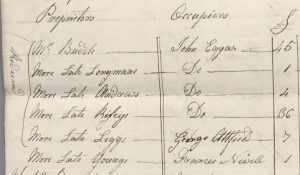
Thomas Buddle died in 1808, his wife predeceasing him by two years. His property in Aldershot was bequeathed in his will to John Eggar, his nephew. Buddle declared that “all that my Halimote Manor or reputed Halimote Manor of Aldershot, and messuages tenements and farms in Aldershot copyhold of the manor of Crondall to John Eggar of Runvale.” The latter was an earlier spelling of Runfold which lies a mile on from the southern boundary of Aldershot. Just what was meant by making the reference to the “reputed Halimote Manor of Aldershot” is unclear.
Thomas Buddle also left £10 to Sarah Wharrard of Runvale the wife of Thomas Wharrard to be paid to her “independently of her husband”.
John Eggar of Aldershot
John Eggar’s ownership is confirmed by the entry in the Land Tax return for 1815 .

John Eggar married in March 1824, to Sarah Whorod, the widow of the “Thomas Wharrard”, who had been mentioned in the will of Thomas Buddle.
-
- Thomas was born in Binsted in 1766; there is also a record of a marriage of a Sarah to a Thomas in December 1797, albeit in Birmingham.
John was aged about 50, his bride then aged 54. They were wed at the Church of St Michael, by licence rather than the reading of the banns. It would seem that this was a private wedding as the stated witnesses did not include other members of the Eggar family. Instead the witnesses signed as William Whorod and June/Jane Whorod
-
- William Whorod, the son of Thomas and Sarah of Runfold, had earlier married a Sarah Smith in Aldershot, in September 1810. She was the daughter of Thomas Smith, a yeoman farmer. William died at age 46, in 1838, buried in Aldershot. William’s elder brother, Henry Whorod of Alton, married Mary, the other daughter of Thomas Smith, a year later in Aldershot in November 1811. The Land Tax Return of 1815 notes that a man called H J Worrard was working the farm at Leggs with John Eggar: likely, this was Henry Whorod.
It is not too fanciful to evoke the attraction of the village as a place to settle and marry from comment made much later about how Aldershot had been before the Army came:
“Aldershot was one of the most pleasant and picturesque hamlets in Hampshire. … The scenery away from the Heath was most rural and romantic … which could vie with any in the neighbourhood as a beautiful and luxuriant landscape.” (Sheldrake, 1859)
Unfortunately, John’s marriage to Sarah did not last long; Sarah died two years later, buried at Bentley in 1826.
May 1829 saw another Eggar married at St Michael’s Church, however. John’s sister Martha married a widower called John Edwards from London. Martha was then aged 42.
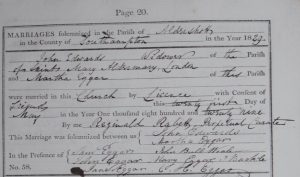
This marriage was celebrated by the wider family, John and several of his siblings signing as witnesses, including Buckle, their brother-in-law.
-
- John’ Eggar’s sister Jane had married John Hancock Buckle in September 1812; he was a solicitor in the City of London. Buckle was a brother-in-law to John and Samuel Eggar, not an uncle, as James Alfred Eggar had first stated.
John Eggar’s Influence
Having the largest landholding, including the ‘Manor Halimote’, John Eggar figured prominently in the affairs of the village. He was, for example, one of the four yeomen who formed a consortium to acquire the advowson for Aldershot as a lease from the Master of St Cross, Winchester. This was the right to collect the tithes and to nominate the curate. The other members of the consortium included James Allden, William Tice (who had married Allden’s sister) and John and Samuel Andrews from Farnham who also held land in Aldershot.
-
- The Land Tax return for 1815 indicates that the lease for the tithes was regard as property, assigned a rateable value of £46 – 10s., slightly more than the £45 assigned to the ‘Manor House estate’.
The yeoman consortium renewed their lease in 1828 for the duration of their lives and for the lives of Richard Allden (then aged 28, the son of James) and James Eggar the Younger (of Hollybourne, then aged 15). They paid £325-15s 5d, equivalent then to the price of 20 horses. The lease carried the obligation to “provide and find an honest able and sufficient Minister or Curate to serve the cure of the said Chapel or Parsonage of Aldershott” and to maintain and keep all in repair and to meet any tax levied.
John Eggar was also likely also the one who had prompted Aldershot to join with his home parish of Bentley in a Gilbert Poor Law Union in 1828, an arrangement which led to paupers from Bentley being housed at the Aldershot Workhouse at a rate of £20 per person per year.
An attempt to sell
Two or three years later, in 1831, something prompted John Eggar, then aged 58, to take steps to sell his Aldershot estate. He instructed Mr George Robins of Covent Garden to put the Aldershot Halimote Manor, House and Estate, up for sale by auction in London as one lot, placing advertisements in several newspapers.
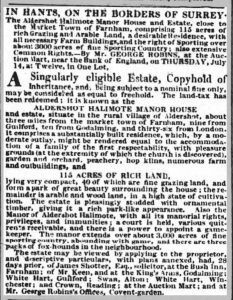 London Evening Standard 15 June 1831
London Evening Standard 15 June 1831
His property was described as a ‘singularly eligible estate’ with land-tax redeemed situated in the rural village of Aldershot with “a substantially built residence, which, by a moderate outlay, might be rendered equal to the accommodation of a family of the first respectability”.
With “115 acres of rich land” the manor was said to extend “over about 3,000 acres of fine sporting country, abounding with game” and that there were “three packs of fox-hounds in the neighbourhood”. It was also said to have rights, privileges and immunities, and “various quitren’s receivables”.
The particulars for the sale in 1831 included a map containing a small graphic of the ‘Manor House’.
For one reason or another the sale did not go ahead. This was during the extended period of depression for agriculture which lasted from 1816 until around 1841; the prospect of a good price might therefore have been low.
The Land Tax return for 1832 shows John Eggar at the “Great House” and also owning Riley’s and Legg’s, that latter being farmed by Stephen Barnett (the father of Caroline, latterly Mrs James Elstone.)

There was another near-contemporary advertisement for other ‘Valuable Copyhold Estates’ in Aldershot put up for auction at the Red Lion in August 1831. These were six lots of ‘eligible copyhold property’, also said to have extensive Common Rights and exonerated Land Tax. One was the ‘valuable and compact estate called Deadbrooks’ having a cottage and large garden and over 26 acres of land. Two lots of property with about 10 acres were along North Lane and three smaller lots, two on the north side of the Canal.
There is therefore distinction to be made between the claim of commoner rights and the additional manorial rights which pertain to the Manor Halimote in the possession of John Eggar.
John Eggar continued to play a central role in the village of Aldershot, serving at least twice as one of the two elected Overseers, the first recorded in 1833, he was a Churchwarden in 1835 and again between 1839 and 1842 and also serving variously as Visitor, Guardian and Surveyor.
Another attempt to sell
The Aldershot Halimote, House and Manor, was advertised as up for sale by auction again in 1835, notice appearing in The Times in June for auction in Farnham in July. The advertisement provides rich details of the interior of the Manor House and its immediate estate, of other farmland and of the uses of the 3,000 acres of heathland.
The advertisement also notes that “it is now only parted with in consequences of his [John Eggar, the proprietor] retiring from agricultural pursuits”; John Eggar was then aged 62.
Once again, the sale also did not take place, John Eggar is listed in the Poor Law Rate Book for 1839 as owning 178 acres of buildings and land for what was described as “Halimote House”, the Rateable Value assessed at £207-16s.
![]()
John Eggar is also recorded as resident in Aldershot by the 1841 Census, his household including his younger brother Thomas and wife Elizabeth, their son Robert and two servants. John was then aged 67.
By 1841, John Eggar’s holding of cultivated land amounted to 210 acres. This was not quite the largest estate in Aldershot, that being the Aldershot Park estate owned by Charles Barron Esq which was a compact 212 acres. Neither estate was large by national standards.

-
- According to the Tithe Survey of 1841/3 John Eggar had to pay a larger rental charge than Charles Barron because there was an ‘extraordinary charge’ for land “cultivated with hops”: just over five of his 156 acres were used for hop growing; Charles Barron had none.
Charles Barron had inherited Aldershot Park in 1828. As the younger man from London, perhaps his arrival might have disturbed John Eggar’s sway over the village and served as one of the thoughts of retirement to Bentley and thus his repeated attempts at selling up.
In 1841, Charles Barron was embarking upon his build of a splendid new mansion, later referred to as Aldershot Place.
Divide and sell
By 1842, John Eggar had secured a buyer for part of his copyhold estate, namely the ‘Manor House’ and its 40 acres of park. It was bought by Matthew Bridges for £2,500.
Possession of the Manor Halimote was seemingly retained by John Eggar who passed that and the remainder of his copyhold property to his younger brother Samuel. Samuel Eggar had much earlier bought Jenkins Place in Bentley and was settled there with his wife Emily. He was listed as a farmer; their nephew Frederick was also in the household in 1841, he too listed as a farmer.
The effects for Manor House were advertised to be sold by auction, without reserve, in July 1842. These included both cattle, horses and household furniture and the like.
 Hampshire Chronicle, 4 July 1842
Hampshire Chronicle, 4 July 1842
When the Report from the Tithe Apportionment Survey of 1841 was published in 1843, the details had been updated to record that the 42 acre Manor House estate, including the Great Meadow, was owned and occupied by Matthew Bridges.
The Tithe Apportionment also notes that John Eggar retained ownership of about 180 acres of farmland, later to be referred to collectively as Manor Farm.
John Eggar departs, another arrives
With John Eggar’s departure from the village, his brother Samuel took over the ownership of Manor Farm, which was subsequently managed by various younger members of the Eggar family, the three nephews who were the sons of John Eggar’s younger brother George.
George’s eldest son was also named John Eggar. Baptised in 1813, he had married in 1840 to Ann Cobden, the niece of Henry Cobden, then an Aldershot resident based at Cross House. (The wedding took place in Herriard, Hampshire.) The couple settled in Aldershot, two of their children being baptised at St Michael’s Church: Frederick Edward in July 1846 and Emily Martha in October 1847. The younger John Eggar also served as an Overseer on the Aldershot Vestry in 1847.
-
- George’s next eldest son was Samuel who was buried in Aldershot in April 1844 at age 29. His younger son Frederick would have been 22; three years earlier he was in Bentley in the household of the older Samuel Eggar.
Samuel Eggar of Bentley also took his brother’s place when the lease for the advowson was renewed. The renewal in May 1846, as “tenants in common”, was for the natural lives of yeoman William Tice of Aldershot, yeoman Samuel Eggar of Bentley, yeoman Richard Allden of Aldershot, widow Harriet Andrews of Farnham and yeoman Charles Andrews of the Grange, Farnham. The cost was £450 “of lawful money of Great Britain”.
Absentee Eggars
By the time of the 1851 Census, there was no one by the name of Eggar living in Aldershot.
George’s son, the younger John Eggar, had left Aldershot and had become the Farm Bailiff for 620 acres of land at Theddon Farm, Alton. It was owned by John Wood, a factory owner from Yorkshire. In 1851, George’s son Frederick Eggar was a steward and land agent on a farm in the New Forest, married with an infant son. He would feature significantly in Aldershot’s history at a much later date. George himself, aged 68, was in Alton in 1851 having retired as a farmer.
The John Eggar who had once been the largest landowner in Aldershot was in Bentley; a widower, aged 77, he was living with two staff close by his older brother James whose two sons who were farming 450 acres in Binsted.
Samuel, 72, was now the owner of about 144 acres in Aldershot, including the farmsteads at Riley’s and Legg’s, collectively referred to as Manor Farm. He was also described in the 1851 Census as a farmer of 265 acres in Bentley employing 16 men and boys.
Let of Manor Farm
In June 1851, Samuel Eggar advertised the let for Manor Farm “with immediate possession”.
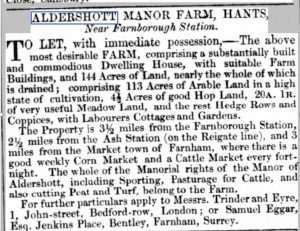 Hampshire Chronicle 21 June 1851
Hampshire Chronicle 21 June 1851
The lot was taken by Henry Twynam. In 1851 he had been farming 250 acres elsewhere in Hampshire at Down Farm House, Whitchurch.
Manor Farm was not the only copyhold property appearing in advertisements that Summer. Locally known as May’s Farm, about 14 acres of farmland and cottages were to be put up for auction as three lots at the Red Lion Inn on 11 July, two fronting onto Aldershot Common. The property had what was described as “valuable and extensive rights appertaining thereto”.
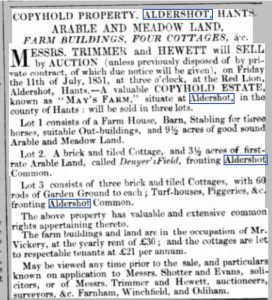 Hampshire Chronicle 28 June 1851
Hampshire Chronicle 28 June 1851
The property was being offered for sale by Mrs Benham; it did not sell and was in her possession, the farm buildings and land still occupied by William Vickery in during 1853.
By 1853, Samuel Eggar was settled in Bentley at age 73. He was an absentee landlord distant from the interests of the village but having advertised as having claim to The whole of the Manorial rights of the Manor of Aldershott, including Sporting, Pasturage for Cattle and also [rights for] cutting Peat and Turf.”
A Work-in-Progress
The extent of rights attached to possession of the Aldershot Manor Halimote is the subject of ongoing research by Peter Burnhill and Sally Jenkinson, the latter having contributed significantly to what is written above.
It is hoped that some form of definitive statement will be available later (in 2022) after additional archival evidence is assessed in the chapters relating to events in the closing months of 1853.
